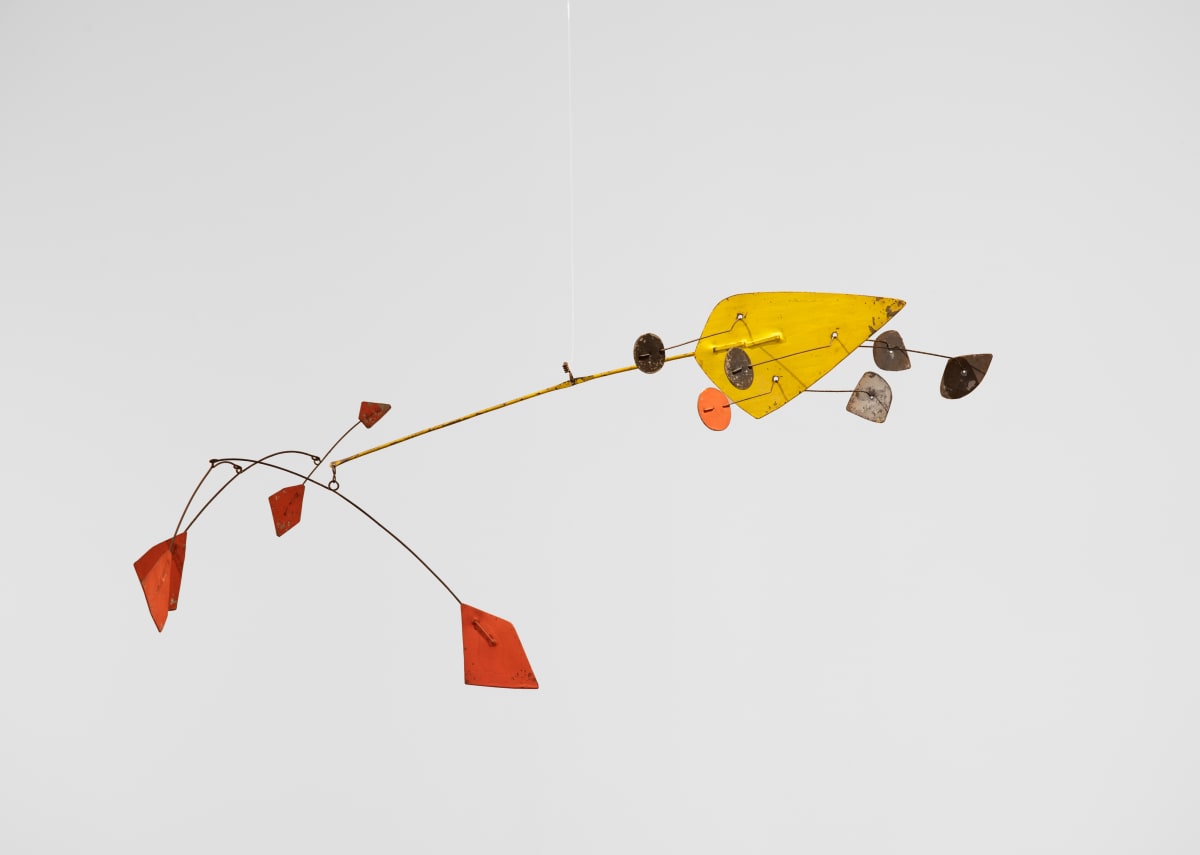![Ohne Titel (Sonambient), circa 1963-64, Brass and beryllium copper [detail]](https://artlogic-res.cloudinary.com/w_1000,h_1000,c_limit,f_auto,fl_lossy,q_auto/ws-hollistaggart/usr/images/artists/bio_image_1/171/htg15862-image-2-.jpg)
A sculptor, designer, and printmaker, Harry Bertoia is known for his cross-genre innovations
A sculptor, designer, and printmaker, Harry Bertoia is known for his cross-genre innovations, including avant-garde sound sculpture, architectural sculptural commissions, and mid-century furniture design. Following collaborations with Charles Eames and Florence Knoll in the 1950s, in the 1960s Bertoia created a series of freestanding tonal sculptures such as Ohne Titel (Sonambient), ca. 1963-64. The sculptures, which range in size from a few inches to twenty feet, feature thin, flexible metal rods that are tightly arranged to resemble a bunch of reeds. The rods are sometimes topped with a cattail-like cylinder to add extra weight and enhance their movement. Bertoia often used beryllium copper for these works because its rich tonal properties produce deep, resonant sounds. In the 1970s, the artist recorded eleven albums of the sounds generated by his Sonambient sculptures.
A sculptor, designer, and printmaker, Harry Bertoia is known for his cross-genre innovations, including avant-garde sound sculpture, architectural sculptural commissions, and mid-century furniture design. Following collaborations with Charles Eames and Florence Knoll in the 1950s, in the 1960s Bertoia created a series of freestanding tonal sculptures such as Ohne Titel (Sonambient), ca. 1963-64. The sculptures, which range in size from a few inches to twenty feet, feature thin, flexible metal rods that are tightly arranged to resemble a bunch of reeds. The rods are sometimes topped with a cattail-like cylinder to add extra weight and enhance their movement. Bertoia often used beryllium copper for these works because its rich tonal properties produce deep, resonant sounds. In the 1970s, the artist recorded eleven albums of the sounds generated by his Sonambient sculptures.
Harry (Arri) Bertoia was born in San Lorenzo, Friuli, Italy in 1915. After studying drawing with a local teacher, when Bertoia was fifteen years old he decided to move to Detroit, where his brother Oreste had settled. After attending Cass Technical High School, Bertoia studied painting and drawing at the Detroit Society of Arts and Crafts. In 1937, he received a scholarship to study at the Cranbrook Academy of Art, an experience that would transform his career. The resident artists at Cranbrook included sculptors, ceramists, and acclaimed architects Walter Gropius and Eliel Saarinen. Among Bertoia’s classmates were Florence Schust (Knoll), Charles Eames, and Eero Saarinen. Eliel Saarinen, who was the Director of the art community at Cranbrook, asked Bertoia to revive the metal working program. Due to metal shortages during World War II, Bertoia initially focused on jewelry, which laid the foundation for his future development as a sculptor. In 1943, Bertoia married fellow Cranbrook student Brigitta Valentiner, the daughter of Wilhelm Valentiner, the Director of Detroit Institute of Arts. Bertoia’s father-in-law, exposed him to modernist maters such as Paul Klee, Wassily Kandinksy, and Joan Miró.
That same year Bertoia moved to California to collaborate with Charles Eames on experimental chair designs. Concurrently, he worked alongside Eames at Evans Products Co., where Eames was director of Research and Development, making airplane parts. At Eames’s suggestion, Bertoia took welding classes. He applied his welding experience to their chair production, but his innovations went un-credited. In 1950 Hans and Florence Knoll invited Bertoia to join Knoll Inc. and he relocated along with Brigitta, and their children to Pennsylvania. At Knoll, Bertoia designed the Diamond Chair, which became an icon of Midcentury Modern furniture design. The success of his chair designs enabled him to purchase a 1750s farmhouse as well as a shop in Bally, Pennsylvania and he expanded his work in sculpture. In 1953 he received a sculptural commission from Eero Saarinen for the altarpiece at the MIT Chapel, which was completed in 1955. Bertoia went on to create numerous public sculptural commissions, including his famous installation of seven gold-plated dandelion-shaped rod sculptures in front of the Kodak building at the 1964 New York World’s Fair.
Bertoia exhibited his sculpture both in the U.S. and abroad including presentations at the Fairweather Hardin Gallery of Chicago and Stamempfli gallery in New York. In 1958 his work was featured at the U.S. Pavilion at the 1958 Brussels World’s Fair. In the 1970s, the final decade of the artist’s career, exhibitions in Olso Norway and Caracas, Venezuela received much acclaim. In 1976 Bertoia was diagnosed with lung cancer, caused in part by his exposure to the toxic fumes from beryllium copper. He died on November 6, 1978 in his home. Bertoia is buried under a massive gong of his own design behind the barn that held his sonambient sculptures.












